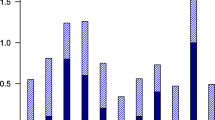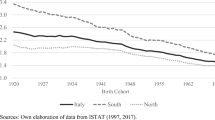Abstract
The study analyzes the role of grandparents’ childcare provision on their adult children’s fertility behavior using data from the Survey of Health, Aging and Retirement in Europe (SHARE) for eleven European countries. An important innovation is that we take into account siblings’ fertility behavior and share of grandparents’ time in terms of childcare. We show that availability of grandparents plays an important role in individuals’ decision of having children. Being helped by grandparents increases the chance of childbearing when existing grandchildren are not too young. On the other hand, the probability of having a child is lower when grandparents are already looking after a sibling’s young child. The role of grandparenting appears stronger in the South of Europe, where public childcare for young children is less prevalent.
Résumé
Cet article étudie l’effet de la prise en charge des enfants par les grands-parents sur le comportement de fécondité de leurs enfants adultes à partir des données des Enquêtes sur la Santé, le Vieillissement et la Retraite en Europe [Survey of Health, Aging and Retirement in Europe (SHARE)] de onze pays européens. Un apport important de notre travail est qu’il tient compte des comportements de fécondité de la fratrie et le partage du temps que les grands-parents accordent à la prise en charge des enfants. Nous montrons que la disponibilité des grands-parents joue un rôle important sur les décisions des individus d’avoir un enfant. Etre aidé par les grands-parents augmente la probabilité de procréer quand les autres petits-enfants existant ne sont pas trop jeunes. En revanche, la probabilité d’avoir un enfant est plus faible quand les grands-parents s’occupent déjà d’un jeune enfant d’un frère ou d’une sœur. Le rôle des grands-parents apparaît plus important en Europe du sud, région où les services de garde pour les jeunes enfants sont moins présents.
Similar content being viewed by others
Notes
There is also a literature that concerns the impact of the extended family on younger generations’ schooling decisions and schooling outcomes. Loury (2006) finds that the more the parents are educated the better the performance of the children. Also the fact that aunts, uncles, and grandparents attended more years of schooling affects the child's school attendance.
The original distance variable was composed of eight categories, ranging from “leaving in the same house” to “living in another country”. We decided to dichotomize it since we wanted to control for feasibility of contacts between the two households (parents and grandparents). We assume that living up to 25 km apart is a reasonable threshold to allow for a frequent exchange of care.
“In couple” has been replaced with 0, “years of schooling” with 13, “work” with 0, “living close to the grandparents” with 0.
“Bad health” is a dummy equal to 1 if the grandparent’s answer to the question “How is your general health?” is worst than the category “good”; 0 otherwise.
Percentages are reported in Table 3.
Data are not available for Switzerland, which has been excluded from this analysis.
The table which reports the estimated effects has not been included but may be obtained from the authors on request.
We test whether each new coefficient (columns a–f) is significantly different from the original one (first column) and always accept the null hypothesis that they are not different.
To our best knowledge, the only survey which contains information on children and childcare provided by distinguished maternal and paternal grandparents is the British Household Panel, in the years 2001 and 2006. From our own elaboration of waves 11 and 16, we find the correlation between paternal and maternal help to be positive and significant (0.202***, N = 1,598).
We face some limitations in the data in terms of information and its variability: out of 100 grandparent-families who help, 40 help in couple, 45 it is only the grandmother, 15 it is only the grandfather (which did not allow us to study the differences between grandmothers and grandfathers); moreover, we do not observe the gender of the grandchild.
Authors’ elaboration from GGSPS, wave 1.
Italia 2020: Programma di azioni per l’inclusione delle donne nel mercato del lavoro (Ministro Carfagna, 2010); La riforma delle pensioni (Ministro Fornero, 2011); La rivoluzione dei congedi (Ministro Riccardi, 2012).
References
Aassve, A., Arpino, B. & Goisis, A. (2012). Grandparenting and mothers’ employment: a comparative perspective. Demographic Research, 27(3), 53–84.
Albertini, M., Kohli, M., & Vogel, C. (2007). Intergenerational transfers of time and money in European families: Common patterns—different regimes? Journal of European Social Policy, 17(4), 319–334.
Andersson, G., Duvander, A. Z., & Hank, K. (2004). Do childcare characteristics influence continued childbearing in Sweden? An investigation of the quantity, quality and price dimension. Journal of European Social Policy, 14(4), 407–418.
Arrondel, L., & Masson, A. (2006). Altruism, exchange or indirect reciprocity: What do the data on family transfers show? In S. C. Kolm & J. Mercier Ythier (Eds.), Handbook on the economics of giving, reciprocity and altruism (pp. 971–1050). North-Holland: Elsevier.
Attias-Donfut, C., & Wolff, F. (2000). The redistributive effects of generational transfers. In S. Arber & C. Attias-Donfut (Eds.), The myth of generational conflict. The family and state in ageing societies (pp. 22–46). London: Routledge.
Bass, S. A., & Caro, F. G. (1996). The economic value of grandparent assistance. Generations, 20(1), 29–33.
Baydar, N., & Brooks-Gunn, J. (1998). Profiles of grandmothers who help care for their grandchildren in the United States. Family Relations, 47(4), 385–393.
Blau, D. M., & Robins, P. K. (1989). Fertility, employment and child-care costs. Demography, 26(2), 287–299.
Bourdieu, P. (1998). Practical reason: On the theory of action. Stanford, CA, USA: Stanford University Press.
Bratti, M. (2003). Female labour force participation and marital fertility of Italian women: The role of education. Journal of Population Economics, 16(3), 525–554.
Chiuri, M. C. (2000). Quality and demand of child care and female labour supply in Italy. Labour: Review of Labour Economics and Industrial Relations, 14(1), 97–118.
De Henau, J., Meulders, D., & O’Dorchai, S. (2007). Making time for working parents: comparing public childcare provision. In D. Del Boca & C. Wetzels (Eds.), Social policies, labour markets and motherhood: A comparative analysis of European countries. Cambridge, UK: Cambridge University Press.
Del Boca, D. (2002). The effect of child care on participation and fertility. Journal of Population Economics, 15(3), 549–573.
Douglas, G., & Ferguson, N. (2003). The role of grandparents in divorced families. International Journal of Law, Policy and the Family, 17(1), 41–67.
Esping-Andersen, G. (2008). Trois leçons sur l’Etat-Providence. Paris: Le Seuil.
Fuller-Thomson, E., & Minkler, M. (2001). American grandparents providing extensive child care to their grandchildren: Prevalence and profile. The Gerontologist, 41(2), 201–209.
Gray, A. (2005). The changing availability of grandparents as carers and its implications for childcare policy in the UK. Journal of Social Policy, 34(4), 557–577.
Hank, K. (2007). Proximity and contacts between older parents and their children: A European comparison. Journal of Marriage and Family, 69(1), 157–173.
Hank, K., & Buber, I. (2009). Grandparents caring for grandchildren: Findings from the 2004 Survey of Health, Ageing and Retirement in Europe. Journal of Family Issues, 30(1), 53–73.
Hank, K., & Kreyenfeld, M. (2003). A multilevel analysis of child care and women’s fertility decisions in West Germany. Journal of marriage and the family, 65(3), 584–596.
Hayslip, B., & Kaminski, P. L. (2005). Grandparents raising their grandchildren: A review of the literature and suggestions for practice. The Gerontologist, 45(2), 262–269.
Herlofson, K., & Hagestad, G. O. (2012). Transformations in the role of grandparents across welfare states. In S. Arber & V. Timonen (Eds.), Contemporary grandparenting: Changing family relationships in a global context. Cambridge, UK: The Polity Press, forthcoming.
Kaptijn, R., Thomese, F., Van Tilburg, T. G., & Liefbroer, A. C. (2010). How grandparents matter support for the cooperative breeding hypothesis in a contemporary Dutch population. Human Nature, 21(4), 393–405.
Knudsen, L. B., & Murphy, M. (2002). The intergenerational transmission of fertility in contemporary Denmark: The effects of number of siblings (full and half), birth order, and whether male or female. Population Studies, 56(3), 235–248.
Kohli, M. & Albertini, M. (2008). The family as a source of support for adult children’s own family projects: European varieties. In Families, Ageing and Social Policy. Intergenerational solidarity in European Welfare States, Globalization and Welfare (pp. 38–58). Cheltenham: Edward Elgar.
Laferrère, A., & Wolff, F. C. (2006). Microeconomic models of family transfers. In J. Mercier Ythier & S. C. Kolm (Eds.), Handbook on the economics of giving, reciprocity and altruism. North-Holland, The Netherlands: North-Holland.
Lehrer, E., & Kawasaki, S. (1985). Childcare arrangements and fertility: An analysis of two-earner households. Demography, 22(4), 499–513.
Loury, L. (2006). All in the extended family: Effects of grandparents, aunts, and uncles on educational attainment. American Economic Review, 96(2), 275–278.
Lyngstad, T. H., & Prskawetz, A. (2010). Do siblings’ fertility decisions influence each other? Demography, 47(4), 923–934.
Marenzi, A., & Pagani, L. (2008). The labor market participation of sandwich generation Italian women. Journal of Family and Economic Issues, 29(3), 427–444.
Mira, P., & Ahn, N. (2002). A note on the changing relationship between fertility and female employment rates in developed countries. Journal of Population Economics, 15(4), 667–682.
Ogawa, N., & Ermisch, J. F. (1996). Family structure, home time demands, and the employment patterns of Japanese married women. Journal of Labor Economics, 14(4), 677–702.
Pebley, A. R., & Rudkin, L. L. (1999). Grandparents caring for grandchildren. What do we know? Journal of Family Issues, 20(2), 218–242.
Rindfuss, R. R., Guilkey, D. K., Morgan, S. P., & Kravdal, O. (2010). Child–care availability and fertility in Norway. Population and Development Review, 36(4), 725–748.
Rindfuss, R. R., Guilkey, D. K., Morgan, S. P., Kravdal, O., & Guzzo, K. B. (2007). Child-care availability and first-birth timing in Norway. Demography, 44(2), 345–372.
Sahlins, M. (1972). Stone age economics. Chicago: Aldine.
Silverstein, M., Giarruso, R., & Bengtson, V. (2003). Grandparents and grandchildren in family systems. A socio-development perspective. In V. Bengtson & A. Lowenstein (Eds.), Global aging and challenges to family (pp. 75–102). New York: Aldine de Gruyter.
Van Galeen, R. I., & Dykstra, P. A. (2006). Solidarity and conflict between adult children and parents: A latent class analysis. Journal of Marriage and Family, 68(4), 947–960.
Vandell, D., McCartney, K., Owen, M., Booth, C., & Clarke-Stew, A. (2003). Variations in child care by grandparents during the first three years. Journal of Marriage and the Family, 65(2), 375–381.
Wheelock, J., & Jones, K. (2002). Grandparents are the next best thing: Informal childcare for working parents in urban Britain. Journal of Social Policy, 31(3), 441–463.
Acknowledgments
We thank participants to the Population Association of America 2010 Annual Meeting (Dallas, 2010), Dondena—Bank of Italy Workshop (Milan, 2010), the Alp Pop Conference (La Thuile, 2011), and the Understanding Society Conference (Colchester, 2011) for comments on an earlier version of the study. We are very grateful to two anonymous referees and to the editor Hill Kulu whose precious suggestions improved our study. We gratefully acknowledge financial support through Starting Grant no StG-201194 “Consequences of Demographic Change” (CODEC) from the European Research Council (ERC).
Author information
Authors and Affiliations
Corresponding author
Rights and permissions
About this article
Cite this article
Aassve, A., Meroni, E. & Pronzato, C. Grandparenting and Childbearing in the Extended Family. Eur J Population 28, 499–518 (2012). https://doi.org/10.1007/s10680-012-9273-2
Received:
Accepted:
Published:
Issue Date:
DOI: https://doi.org/10.1007/s10680-012-9273-2




